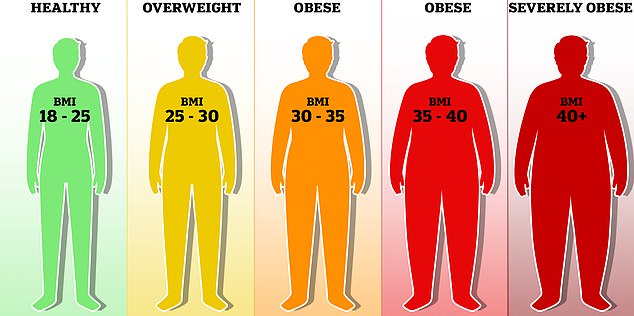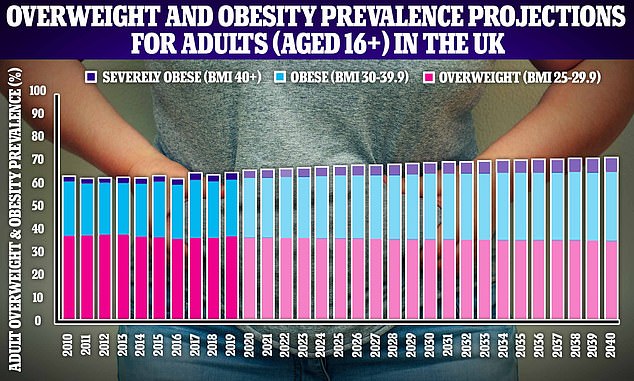Give SLIM People Ozempic! Experts Propose BMI Guidelines Revise That Could Reclassify Millions of Healthy-Weight Britons as ‘Obesity’
Do you have a little beer belly or muffin top but are reassured by your non-obese body mass index (BMI) result? You may still need obesity drugs such as Ozempic, experts have suggested.
Obesity experts are calling for an overhaul of the BMI system, claiming that too many ‘skinny fat’ people, those with a lot of excess fat around their bellies, are not getting obesity treatments that could help them.
This fat, technically called belly fat, wraps around vital organs and is considered more dangerous than subcutaneous fat, which sits just beneath the skin.
A link has been established between high belly fat and an increased risk of heart disease, diabetes, stroke, certain cancers and dementia.
But despite the risks, people can have high levels of belly fat and still not come close to the BMI threshold of 30 that the NHS uses to determine if someone is obese.
Obesity experts are calling for an overhaul of the BMI system, claiming too many ‘skinny fat’ people – those with high levels of excess fat around their bellies – are not receiving obesity treatments that could benefit them.

If the recommendation goes ahead, people with a BMI of over 25 could be advised to take obesity drugs such as semaglutide, sold under the brand names Wegovy and Ozempic. These are currently restricted in the UK to people with a BMI of around 30.
Experts say this means that people who are “skinny fat” are being denied treatments that could improve their health, such as new anti-obesity drugs like the injections Ozempic and Wegovy.
A coalition of experts from the European Association for the Study of Obesity (EASO) has called for an overhaul of the system by which we provide anti-obesity drugs to people with a BMI of 30 or above.
They said that people with a BMI of more than 25 and a waist-to-height ratio (WHtR) of more than 0.5, and the presence of a weight-related health complication, such as high blood pressure or diabetes, should also be considered for anti-obesity drugs.
Belly fat can be measured most accurately with an advanced scan, such as an MRI. However, these scans are expensive and scarce. That’s why experts usually use the WHtR, which is your waist circumference divided by your height.
A result of 0.5 or higher is a general indication that abdominal fat levels are too high.
Writing in the diary Nature communication According to EASO experts, there is currently too much reliance on BMI as a diagnostic criterion for interventions against obesity. This needs to change.
“The basis for this change is the recognition that BMI alone is not a sufficient diagnostic criterion and that body fat distribution has a substantial effect on health,” they wrote.
‘More specifically, abdominal fat accumulation is associated with an increased risk of developing cardiometabolic complications and is a stronger determinant of disease development than BMI, even in individuals with a BMI level below the standard cutoff values for diagnosing obesity (BMI of 30).’
They indicated that pharmaceutical companies may want to use their new diagnostic threshold for a BMI above 25 for new clinical trials of obesity interventions.
The 29 EASO experts who wrote the recommendation were specialists in endocrinology, nutrition, internal medicine, bariatric surgery, primary care and one patient advocate.
In total, 79 percent of the experts consulted agreed that anti-obesity drugs should be considered in patients with a BMI of more than 25, a WHtR of 0.5 or more and the presence of ‘medical, functional or psychological limitations or complications’.

According to the BMI system, a score of 18.5 to 25 is healthy. A score of 25 to 29 is considered overweight, and 30-plus means a person is obese, the stage at which the risk of disease skyrockets.

According to projections by Cancer Research UK, more than 42 million adults in the UK will be overweight or obese by 2040
The NHS is one of the health authorities that uses a BMI of 30 or above as a criterion for prescribing certain anti-obesity drugs.
For example, to receive semaglutide, the active ingredient in both Ozempic and Wegovy, patients must have a BMI of at least 30, or 27.5 if they are from certain ethnic groups. Only then will they be eligible for the drug through the NHS.
Other anti-obesity drugs provided by the NHS have similarly high BMI restrictions.
This is not the first time that experts have called for a revision of the BMI.
BMI was invented in the 1830s by a Belgian mathematician. Doctors have used it as a measure of obesity for almost two centuries.
It is supported by the World Health Organization and is used by doctors around the world to determine whether someone is at risk of a range of diseases, such as diabetes, heart attacks and strokes, due to excess fat.
But there is one major drawback: the device cannot distinguish between fat distribution and muscle mass.
This means that a fit rugby player and a couch potato of exactly the same height and weight will achieve the same scores, even if the former has a muscular body and the other carries a spare tire.
NHS data shows that only 26 per cent of adults have a BMI of 30 or above.
However, the average BMI of all adults over 40 in the UK ranges between 27.7 and 27.6, suggesting that the majority would be considered obese and at risk under the proposed review.
